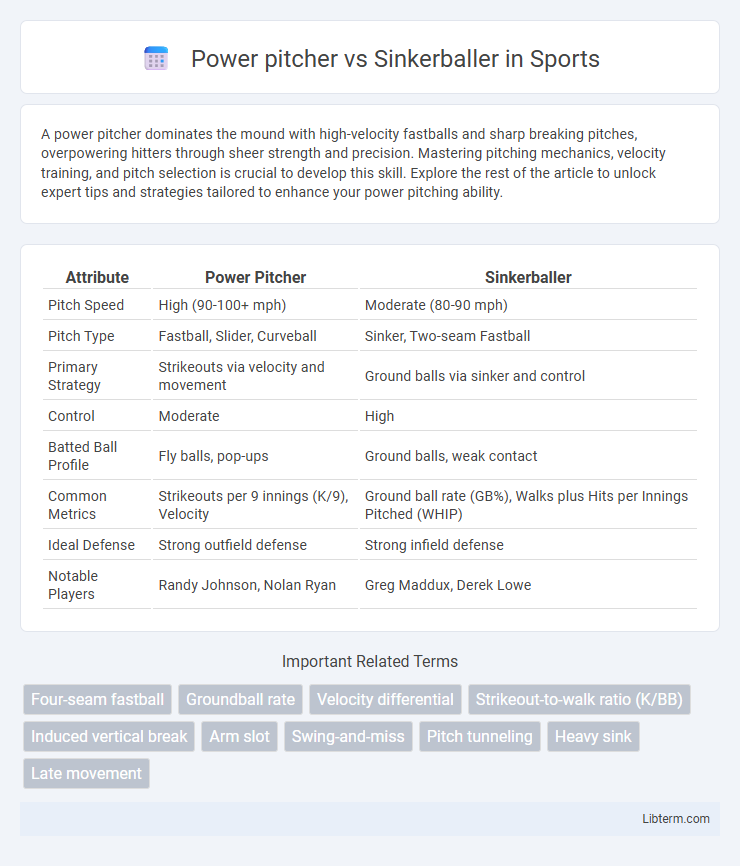A power pitcher dominates the mound with high-velocity fastballs and sharp breaking pitches, overpowering hitters through sheer strength and precision. Mastering pitching mechanics, velocity training, and pitch selection is crucial to develop this skill. Explore the rest of the article to unlock expert tips and strategies tailored to enhance your power pitching ability.
Table of Comparison
| Attribute | Power Pitcher | Sinkerballer |
|---|---|---|
| Pitch Speed | High (90-100+ mph) | Moderate (80-90 mph) |
| Pitch Type | Fastball, Slider, Curveball | Sinker, Two-seam Fastball |
| Primary Strategy | Strikeouts via velocity and movement | Ground balls via sinker and control |
| Control | Moderate | High |
| Batted Ball Profile | Fly balls, pop-ups | Ground balls, weak contact |
| Common Metrics | Strikeouts per 9 innings (K/9), Velocity | Ground ball rate (GB%), Walks plus Hits per Innings Pitched (WHIP) |
| Ideal Defense | Strong outfield defense | Strong infield defense |
| Notable Players | Randy Johnson, Nolan Ryan | Greg Maddux, Derek Lowe |
Understanding Power Pitchers: Definition and Traits
Power pitchers rely on high velocity fastballs and overpowering strikeout ability to dominate hitters, often featuring fastball speeds exceeding 95 mph. Their traits include exceptional arm strength, aggressive pitching style, and a focus on strikeouts rather than inducing groundballs or weak contact. Power pitchers typically have higher strikeout rates and rely less on pitch movement or location compared to sinkerballers.
What is a Sinkerballer? Key Characteristics
A sinkerballer is a type of pitcher known for throwing sinkers--fastballs with significant downward movement--that induce ground balls and weak contact, making them effective for generating double plays. Key characteristics include a focus on control and movement over velocity, relying on sinker grips and arm angles to produce late sinking action. Unlike power pitchers who prioritize high velocity and strikeouts, sinkerballers excel at pitching to contact and minimizing home runs by keeping the ball low in the strike zone.
Mechanics: Power Pitchers vs. Sinkerballers
Power pitchers rely on high arm speed and explosive lower body drive to generate maximum velocity, often emphasizing a strong, over-the-top arm slot to maximize fastball speed. Sinkerballers focus on a more refined release point with subtle wrist pronation and finger pressure to create downward movement, optimizing pitch control and inducing ground balls. The mechanical difference lies in power pitchers prioritizing velocity while sinkerballers emphasize movement and command through precise spin and arm angle adjustments.
Velocity and Movement: Comparing Pitching Styles
Power pitchers rely on high velocity, often exceeding 95 mph, to overpower hitters with fastballs that have straight, late movement. Sinkerballers focus on generating ground balls through sinkers with velocities generally in the mid-80s to low-90s mph, using significant downward movement to induce weak contact. The contrast in pitching style hinges on speed-oriented dominance versus movement-driven deception to achieve outs.
Impact on Batter Matchups
Power pitchers dominate batter matchups by relying on high-velocity fastballs and overpowering breaking pitches, forcing hitters into defensive swings and increasing strikeout rates. Sinkerballers impact matchups through inducing ground balls and weak contact with their sinking fastballs, leading to quick outs and double-play opportunities. Batters often adjust approach based on pitch type, with power pitchers challenging timing and sinkerballers exploiting contact tendencies.
Influence on Game Strategy and Defense
Power pitchers shape game strategy by challenging batters with high velocity and strikeout potential, forcing defenses to anticipate strikeouts and rely on strong catchers for framing. Sinkerballers influence defense by inducing ground balls, encouraging infielders to position strategically for double plays and quick outs. Teams adjust pitching approaches and defensive alignments based on the pitcher's style to optimize run prevention and control the game tempo.
Performance Metrics: Stats That Matter
Power pitchers dominate with high strikeout rates (K/9) and elevated fastball velocity, often exceeding 95 mph, making them strikeout specialists who rely on overpowering hitters. Sinkers prioritize inducing ground balls, reflected in superior ground ball rates (GB%), lower home run per nine innings (HR/9), and efficient pitch-to-contact strategies that limit extra-base hits. Key performance metrics differentiating the two include strikeout-to-walk ratio (K/BB) for power pitchers versus ground ball percentage and batting average on balls in play (BABIP) for sinkerballers, highlighting contrasting approaches to run prevention.
Injury Risk and Longevity
Power pitchers, who rely on high-velocity fastballs often exceeding 95 mph, face increased injury risk due to the intense stress placed on shoulder and elbow ligaments, leading to higher incidences of ulnar collateral ligament (UCL) tears and rotator cuff strains. Sinkers, emphasizing movement and lower velocity in the low 90s mph range, generally exhibit greater longevity by reducing joint torque and promoting refined mechanics that mitigate overuse injuries. Studies indicate sinkerballers maintain more consistent career spans, with reduced downtime from Tommy John surgeries compared to power pitchers, underscoring the durability advantages of pitch selection and delivery style.
Notable Power Pitchers and Sinkerballers in MLB History
Notable power pitchers in MLB history include Nolan Ryan, Randy Johnson, and Justin Verlander, who dominated hitters with high-velocity fastballs and strikeout prowess. Renowned sinkerballers like Greg Maddux, Roy Halladay, and Derek Lowe excelled by generating ground balls and inducing weak contact through their pinpoint sinkers. These pitchers shaped their eras by exploiting distinct pitching styles to consistently challenge and outsmart opposing batters.
Choosing the Right Style: Development and Training
Choosing between a power pitcher and a sinkerballer hinges on tailored development and training methods that enhance individual strengths. Power pitchers benefit from strength conditioning, velocity drills, and strikeout pitch refinement to maximize fastball speed and movement. Sinkerballers require focused mechanics on grip, sink, and ground-ball control, emphasizing endurance and precision to exploit heavy sink and induce weak contact.
Power pitcher Infographic

 libterm.com
libterm.com